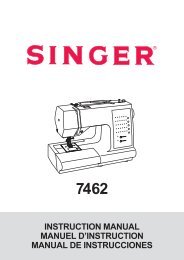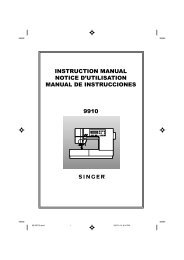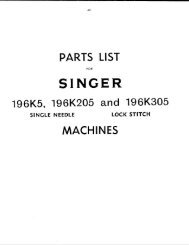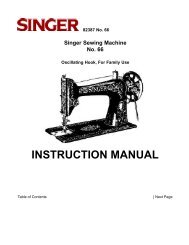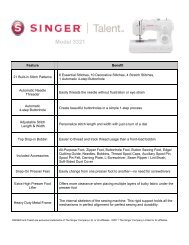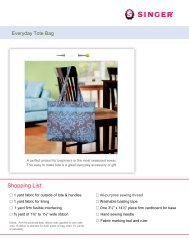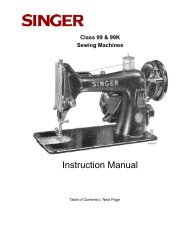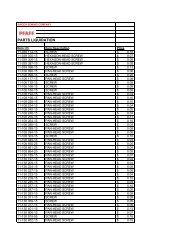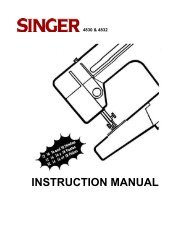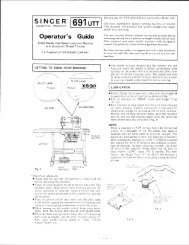Instruction Book Libro de Instrucciones Livret d'Instructions ... - Singer
Instruction Book Libro de Instrucciones Livret d'Instructions ... - Singer
Instruction Book Libro de Instrucciones Livret d'Instructions ... - Singer
You also want an ePaper? Increase the reach of your titles
YUMPU automatically turns print PDFs into web optimized ePapers that Google loves.
Stretch blindhem<br />
(only for machines with 5<br />
and 10 stitches)<br />
This stitch can be used for stretch seams and<br />
<strong>de</strong>corative stitching.<br />
Elastic insertion<br />
Recommen<strong>de</strong>d Settings<br />
Stitch Selection: Stretch blindhem (E)<br />
Needle Position:<br />
Stitch Width:<br />
Stitch Length: 1-2<br />
Foot: Special Purpose (J)<br />
Needle Plate: General Purpose (A)<br />
Fit elastic for snugness and allow 1 inch (25<br />
mm) for joining. Lap the two ends and stitch.<br />
Devi<strong>de</strong> elastic and garment into equal<br />
quarters. Place elastic over the fabric and pin<br />
the two together at these points keeping top<br />
edges even.<br />
Anchor the elastic to the fabric with a few<br />
stitches. Now stretch elastic between the pins<br />
as you sew, using both hands to hold elastic<br />
tight in front and back of presser foot.<br />
Lace insertion<br />
12 3 4 5<br />
Lace is inserted after fabric is cut, but before it is<br />
sewn together.<br />
Punto invisible elásticos<br />
(solamente para máquinas con<br />
5 y 10 mo<strong>de</strong>los <strong>de</strong> puntos)<br />
Este punto pue<strong>de</strong> utilizarse para costura<br />
extensible y para puntadas <strong>de</strong>corativas.<br />
Inserción <strong>de</strong> elásticos<br />
Posiciones recomendadas<br />
Selección punto: Punto invisible elásticos (E)<br />
Posición aguja:<br />
Anchura punto:<br />
12 3 4 5<br />
Longitud punto: 1-2<br />
Prensatelas: Uso especial (J)<br />
Plancha aguja: Uso general (A)<br />
Ajuste el elástico bien aparejado y <strong>de</strong>je 25mm<br />
para su unión. Solape los dos extremos y<br />
cosa.<br />
Divida el elástico y la prenda en cuartos<br />
iguales. Coloque el elástico sobre el tejido y<br />
una con alfileres ambos por los cuartos <strong>de</strong><br />
unión, manteniendo los extremos<br />
uniformemente.<br />
Asegure el elástico al tejido con más<br />
puntadas. Después, estire el elástico entre los<br />
alfileres según cose, utilizando ambas manos<br />
para mantener el elástico terso por <strong>de</strong>lante y<br />
por <strong>de</strong>trás <strong>de</strong>l prensatelas.<br />
Inserción <strong>de</strong> galones y encajes<br />
El galón se inserta <strong>de</strong>spués <strong>de</strong> cortar el tejido,<br />
pero antes se cose junto.<br />
Repriser<br />
Avec un peu <strong>de</strong> pratique usures et trous dans les<br />
vêtements d’enfant comme dans le linge <strong>de</strong><br />
maison peuvent être reprisés facilement et sans<br />
effort. S’il s’agit <strong>de</strong> gran<strong>de</strong>s reprises, utilisez un<br />
cercle à bro<strong>de</strong>r et le pied presseur à repriser que<br />
vous pourrez acheter dans votre magasin<br />
SINGER.<br />
Réglages recommandés<br />
Sélection <strong>de</strong> point: Point droit (A)<br />
Position d’aiguille:<br />
Largeur <strong>de</strong> point:<br />
Longueur <strong>de</strong> point: 2-5<br />
Pied presseur: Universel (B)<br />
Plaque à aiguille: Universelle (A)<br />
Couvre griffe (F)<br />
Si le tissu est troué, batissez un tissu <strong>de</strong> renfort<br />
sous l’ouverture.<br />
Placez sous le pied presseur la partie à<br />
repriser, l’endroit du tissu au-<strong>de</strong>ssus. Baissez<br />
le pied presseur et commencez à repriser en<br />
imprimant délicatement au tissu un<br />
mouvement <strong>de</strong> va et vient.<br />
Continuez ce mouvement <strong>de</strong> va et vient jusqu’à<br />
ce que la partie à repriser soit recouverte <strong>de</strong><br />
lignes bien parallèles.<br />
Matelassage<br />
Le matelassage consiste à surpiquer 2 ou<br />
plusieurs épaisseurs <strong>de</strong> tissu en suivant un<br />
<strong>de</strong>ssin. Un molleton est généralement utilisé<br />
pour donner un effet <strong>de</strong> gonflant.<br />
Réglages recommandés<br />
Sélection <strong>de</strong> point: Point droit (A)<br />
Recommen<strong>de</strong>d Settings<br />
Posiciones recomendadas<br />
Position d’aiguille:<br />
Stitch Selection: Stretch blindhem (E)<br />
Selección punto: Punto invisible elásticos (E)<br />
Largeur <strong>de</strong> point:<br />
Needle Position:<br />
Posición aguja:<br />
Longueur <strong>de</strong> point:<br />
12 3<br />
2-5<br />
4 5<br />
Stitch Width:<br />
12 3 4 5<br />
Anchura punto:<br />
12<br />
3 4 5<br />
Pied presseur:<br />
Plaque à aiguille:<br />
Universel (B)<br />
Universelle (A)<br />
Stitch Length:<br />
Foot:<br />
Needle Plate:<br />
½-2<br />
Special Purpose (J)<br />
General Purpose (A)<br />
Longitud punto:<br />
Prensatelas:<br />
Plancha aguja:<br />
½-2<br />
Uso especial (J)<br />
Uso general (A)<br />
Sur l’endroit du tissu, reproduisez le <strong>de</strong>ssin<br />
choisi à l’ai<strong>de</strong> d’une craie ou d’un crayon<br />
lavable.<br />
Cut lace to <strong>de</strong>sired size.<br />
Position lace on right si<strong>de</strong> of fabric and pin in<br />
place.<br />
Place the work un<strong>de</strong>r the presser foot so that<br />
the stitches fall over the lace edges, as shown.<br />
After both si<strong>de</strong>s of lace are sewn, turn fabric<br />
over to the back si<strong>de</strong> and cut the fabric on<br />
both si<strong>de</strong>s close to the stitching lines and<br />
remove.<br />
Corte el galón al tamaño <strong>de</strong>seado.<br />
Colocar el galón sobre el <strong>de</strong>recho <strong>de</strong>l tejido y<br />
unirlo con alfileres.<br />
Coloque la labor <strong>de</strong>bajo <strong>de</strong>l prensatelas <strong>de</strong><br />
manera que los puntos caigan sobre los<br />
bor<strong>de</strong>s <strong>de</strong>l galón, como se muestra.<br />
Una vez cosidos ambos lados <strong>de</strong>l galón,<br />
vuelva el tejido <strong>de</strong>l revés y corte el tejido sobre<br />
ambos lados junto a las líneas <strong>de</strong> costura y<br />
retirar.<br />
Doublez l’envers du tissu avec un molleton<br />
sous lequel vous placerez également un tissu<br />
léger genre batiste.<br />
Batissez pour éviter le glissement <strong>de</strong>s<br />
différentes couches <strong>de</strong> tissu.<br />
Placez le tissu sous le pied presseur et piquez<br />
avec précaution en suivant le <strong>de</strong>ssin.<br />
Si vous matelassez un très grand ouvrage,<br />
commencez à travailler du centre vers les<br />
bords en lissant fréquemment le travail<br />
pendant la piqûre.<br />
52 37<br />
12 3 4 5



